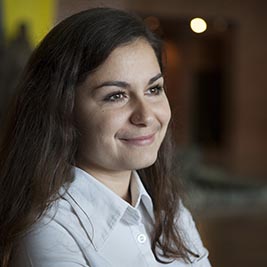Bank of Portraits / Larzhevsky Raisa, Mykola, Leonid and Ivan, Hubar Oleksiy

Larzhevsky Raisa, Mykola, Leonid and Ivan, Hubar Oleksiy
The Larzhevsky family lived in the city of Uman in the Kyiv region (now Cherkasy region).
On the eve of World War II, an elderly mother and her younger son Ivan remained in the city. Daughter Raisa Larzhevska and older sons Mykola and Leonid were students of the Dnipropetrovsk State University (now Oles Honchar Dnipro National University). At the university, the Larzhevskys were friends with Raisa Dudnyk, also a native of Uman. The four young people often went home for holidays.
In August 1941, three Larzhevskys and a friend returned to their hometown occupied by the Germans. Here Raisa Dudnyk, her parents, and younger sister Haya, like all Uman Jews, suffered severe persecution. On October 1, 1941, obeying the German order, the Dudnyk family moved to the ghetto. Its residents were strictly forbidden to leave the enclosed area, but hunger forced the sisters to go beyond the fence and ask familiar Ukrainians to help with food. When they reached the Larzhevsky house, they provided them with food and persuaded them to spend the night.
It was then that a punitive action was organized in the ghetto, during which the parents of Raisa and Haya died along with thousands of other Jews. So, despite the material hardship, the Larzhevskys immediately offered the sisters to stay with them. In early 1942, Ivan, an underground member of the OUN, brought another Jewish woman with a 12-year-old daughter into the house. The boy once met them in the ghetto, visiting the Dudnyks there. Four Jews hid in the Larzhevsky house until May 1942. All this time their dwelling also served as a conspiratorial apartment of the OUN underground (Leonid became a member of the OUN while still at the university, had the pseudonym “Yavir”). Also, the fugitives regularly received food aid from Oleksiy Hubar, the leader of the Uman members of the OUN (pseudonym “Zaporozhets”) and a good acquaintance of Raisa Dudnyk.
In May 1942, when raids and searches for hiding Jews intensified, Oleksiy obtained a forged Soviet passport for Raisa in the name of a Ukrainian woman Lukia Korotenko and helped her leave the city. Later, it was possible to save Haya Dudnyk. The Larzhevskys gave her the birth certificate of their cousin-Ukrainian, and Oleksa Hubar forged a reference from an orphanage for the appropriate name and arranged for the girl to work in the village of Nebelivka, which is 50 km from Uman.
The Dudnyk sisters managed to survive the Holocaust and reunite after the Hitlerites were expelled from the region in April 1944.
What happened to the rescuers themselves? Raisa and Mykola Larzhevsky left with the retreating Germans in 1943. They ended up in Norway, in labor camps. Mykola worked in quarries until 1945. He signed a letter to the Red Cross asking not to be returned to the USSR. But he was arrested by Soviet authorities for this and sentenced to 10 years in camps. Having served his term, he lived in special settlement in Kazakhstan. There he got married, had two children. He worked at a car base as a foreman, head of one of the departments. He died in September 1987. Posthumously rehabilitated.
Raisa, after the German labor camps, returned to Uman. Later she worked as an accountant. She died in 1989. Any data on the membership of Mykola and Raisa in the OUN are absent.
Leonid Larzhevsky became a referent of the OUN Security Service in mid-1942. Trying to save a comrade from a German prison, he himself ended up in a camp. At the end of July 1943, he escaped. Soon he became the head of the Crimean leadership of the OUN. He was building a local organization. After the peninsula was captured by the Red Army, he returned to Uman. The NKVD first arrested Leonid in 1944, releasing him on condition of further cooperation. But he was engaged in disinformation. He was arrested for the second time in September 1945. He received 10 years in camps in the Magadan region, where he fell ill with tuberculosis. After being released, he worked as an excavator operator at gold deposits in the special settlement of the village of Novy Kadikchan. Then he got married. A son was born. At the end of the 1960s, he returned to Uman, where he worked at a brick factory. Soon he divorced his wife. He received a pension as a disabled person from authorities and died of tuberculosis in August 1987. In 1995, Leonid was rehabilitated.
Ivan Larzhevsky was in a conspiratorial apartment. As an OUN agent, he established contact with the Russian emigrant organization NTS, representatives of which were then in Uman. The last time he was seen at home in the winter of 1943-1944 with a weapon in his hands. According to his brother Leonid, Ivan went to the UPA and lost contact with him. According to other data, he retreated with the Germans.
Oleksa Hubar in 1943 became one of the leaders of the OUN in the Uman region. He recruited people to the UPA. After the arrival of the Red Army, he remained in the rear. He escaped from arrest several times, even tried to do it after the amputation of his leg. In 1945, he was sentenced to execution. Already in independent Ukraine, in 1992, the Military Tribunal of the Kyiv Military District refused to rehabilitate him…
On September 10, 1995, Yad Vashem honored Raisa Larzhevska, her brothers Mykola, Leonid and Ivan Larzhevsky, as well as Oleksiy Hubar with the honorary title “Righteous Among the Nations”.

Nadiya Simperovych
Kyiv
National museum of the History of Ukraine in the Second World War
-
fingerprintArtefacts
-
theatersVideo
-
subjectLibrary



